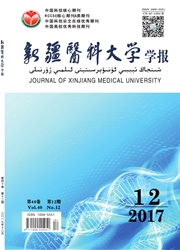

 中文摘要:
中文摘要:
目的了解肺结核病患者甲、乙、丙3型病毒性肝炎的分布特征,为在肺结核病人中开展甲、乙、丙3型病毒性肝炎知识宣传教育和干预工作提供参考依据。方法收集新疆部分地区肺结核患者的一般资料,采集血清,用酶联免疫吸附(EuSA)法检测甲肝抗体IgM(抗HAV-IgM)、丙肝抗体IgG(抗HCV—IgG)以及乙肝(HBV)抗原抗体系统3项血清学指标即乙肝标志物(HBV-M):乙肝表面抗原(HBsAg)、表面抗体(抗-HBs)和核心抗体(抗-HBc),并对其进行分析。结果采集肺结核病患者有效血清标本共1355份,各指标阳性率分别为抗-HAV5.46%、抗-HCV3.47%、HBsAg6.64%、HBV感染率55.06%。北疆各指标抗HAV—IgM(5.99%)、抗HCV-IgG(5.58%)、HBsAg(10.74%)、HBV感染(63.02%)的阳性率均高于南疆[抗HAVIgM(5.17%)、抗HCV-IgG(2.30%)、HBsAg(4.36%)、HBV感染(50.63%)],除抗HAV-IgM外,差异均有统计学意义。男性各指标抗HAV—IgM(6.87%)、抗HCV-IgG(4.71%)、HBsAg(7.25%)、HBV感染(56.36%)阳性率均高于女性(抗HAV-IgM(3.51%)、抗HCV—IgG(1.76%)、HBsAg(5.80%)、HBV感染(53.25%)),除HBsAg和HBV感染外,抗HAV-IgM和抗HCV-IgG阳性率差异有统计学意义。≥65岁组与〈65岁组相比,抗HAV-IgM阳性率差异有统计学意义(Y。一6.64,P〈O.05);HBsAg和HBV的阳性率均以65~75岁组最高(8.43、64.04%);抗HCV-IgG阳性率以25~35岁组最高(6.69%),各年龄组差异有统计学意义(x2=12.524,P=0.028)。除抗HCV-IgG外,不同民族问抗HAV-IgM、HBsAg和HBV的阳性率差异有统计学意义(P〈0.05);抗HAV—IgM阳性率其他民族最高(13.92%);HgsAg和HgV的阳性率汉族最高(12.5%、77.98%);抗HCV-IgG阳性率哈萨克族最高(6.90%)。结论肺结核病人甲、丙型?
 英文摘要:
英文摘要:
Objective To know about the distribution characteristics of three types of viral hepatitis A, B and C among tuberculosis (TB) patients in parts of xinjiang province. Methods A study was conducted on TB patients in parts of Xinjiang province. Demographic information and blood samples were collected. Ser- um were tested for hepatitis A antibody-IgM (anti-HAV-IgM) and hepatitis C antibody-IgG (anti-HCV- IgG) using ELISA, besides serologic markers of hepatitis B. surface antigen (HBsAg), surface antibody (anti-HBs) and core antibody (anti-HBc) were detected, then analyze these datum. Results Laboratory data were available for 1 355 participants in TB patients. The positive rate of anti-HAV, anti-HCV, HB- sAg and infection of HBV were 5. 46%, 3.47%, 6.64% and 55.06 respectively. The positive rates of all indicators in north of Xinjiang were higher than the south (anti-HAV.. 5. 99% vs 5. 17%, anti-HCV: 5.58% vs 2.30%, HBsAg. 10.74% vs 4.36%, infection of HBV. 63.02% vs 50.63%). Differences were statistically except anti-HAV. High positive rate of all indicators were noticed in males than females (anti HAV. 6.87% vs 3.51%, anti-HCV. 4.71% vs 1.76%, HBsAg: 7.25% vs 5.80%, infection of HBV. 56.36% vs 53.25%). Anti-HAV and anti-HCV positive rate were significant different except HBsAg and infection of HBV. Anti-HAV positive rate was different in ~65 age group and ~65 age group (;t2 =6.64, P d0.05). The HBsAg positive rate and infection of HBV were the highest in 65~75 age group (8.43, 64.04%). The anti-HCV was different in each age group (X2 =12. 524, P =0. 028) and the highest in 25 -35 age group. There was a meaningful difference of all positive rate except anti-HCV among every ethnic group. The highest positive rate of each indicators was the others in anti-HAV (13.92%), Han in HBsAg (12.5%) and HBV (77.98%), Kazak in anti-HCV (6.90%) res the positive rates of viral hepatitis A and C among TB patients are pectively. Conclusion The results show higher than t
 同期刊论文项目
同期刊论文项目
 同项目期刊论文
同项目期刊论文
 期刊信息
期刊信息
